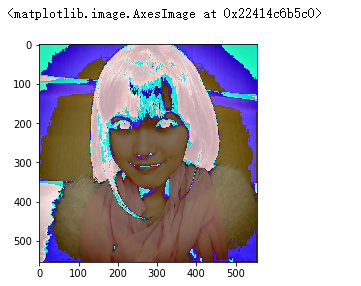数据分析-numpy模块
1、numpy模块
1.简介
- NumPy(Numerical Python) 是 Python 语言中做科学计算的基础库。重在于数值计算,也是大部分Python科学计算库的基础,多用于在大型、多维数组上执行的数值运算。
- numpy当成是一个一维或者多维的数组
2. numpy的创建
- 使用 np.array()创建
- 使用plt创建
- 使用np的routines函数创建
- 使用array()创建一个一维数组
# 创建一维数组
import numpy as np
arr = np.array([1,2,3,4,5])#创建一维数组
arr
# 输出结果
#arr([1,2,3,4,5])
# 使用array()创建一个多维数组
import numpy as np
np.array([[1,2,3],[4,5,6]])#创建二维数组
#输出结果:array([[1,2,3],[4,5,6]])
3.数组和列表的区别
- 列表中可以存储不同类型的数据
- 数组中存储的数据元素类型必须一致
- str>float>int数据类型的优先级
示例
import numpy as np
np.array([[1,2,3],[4,'five',6]])
# 输出结果
# array([['1','2','3'],['4','five','6']],dtype='<U11')
4. 将外部的一张图片读取加载到numpy数组中
1.加载到numpy数组中
# 将外部的一张图片读取加载到numpy数组中,然后尝试改变数组元素的数值查看对原始图片的影响
import matplotlib.pyplot as plt
#图片数据的读取
img_arr = plt.imread('./1.jpg')
img_arr
# 输出结果
array([[[129, 86, 31],#前两个参数代表像素 后一个参数代表 颜色
[129, 86, 31],
[130, 87, 32],
...,
[111, 77, 39],
[102, 75, 45],
[255, 239, 212]]],dtype=uint8)
#将一个三维的numpy数组显示成一张图片
pit.imshow(img_arr-100)

2.图片反转
#将一张图片反转
plt.imshow(img_arr[::-1,::-1,::-1])

5. zeros、ones、linespace、arange、random
zeros、ones
import numpy as np
np.zeros(shape=(3,4))
# 输出结果
array([[0., 0., 0., 0.],
[0., 0., 0., 0.],
[0., 0., 0., 0.]])
np.ones(shape=(3,4))
# 输出结果
array([[1., 1., 1., 1.],
[1., 1., 1., 1.],
[1., 1., 1., 1.]])
linspace、arange random 一维等差数列
import numpy as np
np.linspace(0,100,num=20)
# 输出结果
array([ 0. , 5.26315789, 10.52631579, 15.78947368,
21.05263158, 26.31578947, 31.57894737, 36.84210526,
42.10526316, 47.36842105, 52.63157895, 57.89473684,
63.15789474, 68.42105263, 73.68421053, 78.94736842,
84.21052632, 89.47368421, 94.73684211, 100. ])
import numpy as np
np.arange(0,100,2)
#输出结果
array([ 0, 2, 4, 6, 8, 10, 12, 14, 16, 18, 20, 22, 24, 26, 28, 30, 32,
34, 36, 38, 40, 42, 44, 46, 48, 50, 52, 54, 56, 58, 60, 62, 64, 66,
68, 70, 72, 74, 76, 78, 80, 82, 84, 86, 88, 90, 92, 94, 96, 98])
import numpy as np
np.random.randint(0,80,size=(5,8))
# 输出结果
array([[29, 8, 73, 0, 40, 36, 16, 11],
[54, 62, 33, 72, 78, 49, 51, 54],
[77, 69, 13, 25, 13, 30, 30, 12],
[65, 31, 57, 36, 27, 18, 77, 22],
[23, 11, 28, 74, 9, 15, 18, 71]])
np.randodm.random(size=(3,4))
# 输出结果
array([[0.0768555 , 0.85304299, 0.43998746, 0.12195415],
[0.73173462, 0.13878247, 0.76688005, 0.83198977],
[0.30977806, 0.59758229, 0.87239246, 0.98302087]])
6.随机因子 seed
#随机因子(系统时间):无时无刻都在变化的值
#随机因子固定下来,随机性就固定
import numpy as np
np.random.seed(10)
np.random.randint(0,100,size=(2,3))
# 输出结果
array([[ 9, 15, 64],
[28, 89, 93]])
7. numpy的常用属性
# shape、ndim、size、dtype
import numpy as np
arr = np.random.randint(0,100,size=(5,6))
arr
# 输出结果
array([[88, 11, 17, 46, 7, 75],
[28, 33, 84, 96, 88, 44],
[ 5, 4, 71, 88, 88, 50],
[54, 34, 15, 77, 88, 15],
[ 6, 85, 22, 11, 12, 92]])
arr.shape#形状(重点)
# 输出结果(5,6)
arr.ndim#维度数
# 输出结果 2
arr.size#数组的长度
#输出结果 30
arr.dtype#数组元素的类型(重点)
# 输出结果:dtype('int32')
type(arr)
# 输出结果 numpy.ndarray
8. numpy的数据类型(数组元素的类型)
- array(dtype=?):可以设定数据类型
- arr,dtype='?':可以修改数据类型

# 通过dtype修改数据的数据类型
arr.dtype = 'int16'
arr.dtype
#输出结果:dtype('int16')
9. numpy的索引和切片操作
简介
意义:可以让我们取出numpy数组中任意指定的局部数据
索引操作和列表同理
索引操作
import numpy as np
arr = np.random.randint(0,100,size=(5,6))
# 取一行
arr[1]
# 取多行
arr[[1,2,3]]
切片操作
# 切出前两列数据
# 切出前两行数据
# 切出前两行的前两列的数据
# 数组数据翻转
# 练习:将一张图片上下左右进行翻转操作
# 练习:将图片进行指定区域的裁剪
import numpy as np
arr = np.random.randint(0,100,size=(5,6))
# 切出前两行数据
arr[0:2]
# 切除前两列数据
arr[:,0:2]
# 切出前两行的前两列的数据
arr[0:2,0:2]
# 列反转
arr[:,::-1]
#行反转
arr[::-1]
# 元素反转
arr[::-1,::-1]
10. 变形reshape,级联操作
1. reshape
import numpy as np
arr = np.array([[1,2,3],[4,5,6]])
arr
# 输出结果
array([[1, 2, 3],
[4, 5, 6]])
# 多维变一维
arr_1 = arr.reshape((6,))
arr_1
#输出结果:array([1, 2, 3, 4, 5, 6])
# 一维变多维
arr_1.reshape((6,1))
arr_1.reshape((3,-1)) #-1表示自动计算行或者列数
# 输出结果 array([[1,2],[3,4],[5,6]])
2. 级联操作
就是将多个numpy数组进行横向或者纵向的拼接
axis轴向的理解
import numpy as np
arr = np.array([[1,2,3],[4,5,6]])
n_arr = arr
display(arr,n_arr)
# 输出结果
array([[ 9, 53, 94, 60, 44, 86],
[29, 69, 14, 17, 11, 24],
[ 8, 30, 39, 5, 19, 67],
[55, 33, 6, 16, 57, 48],
[19, 69, 12, 52, 27, 0]])
array([[ 9, 53, 94, 60, 44, 86],
[29, 69, 14, 17, 11, 24],
[ 8, 30, 39, 5, 19, 67],
[55, 33, 6, 16, 57, 48],
[19, 69, 12, 52, 27, 0]])
3. 匹配级联
进行级联的多个数组的形状是完全一样
import numpy as np
arr = np.array([[1,2,3],[4,5,6]])
n_arr = arr
np.concatenate((arr,n_arr),axis=0)
#输出结果
array([[1, 2, 3],
[4, 5, 6],
[1, 2, 3],
[4, 5, 6]])
#不匹配级联
#维度一致,但是行列个数不一直
#横向级联:保证行数一致
#纵向级联:保证列数一致



